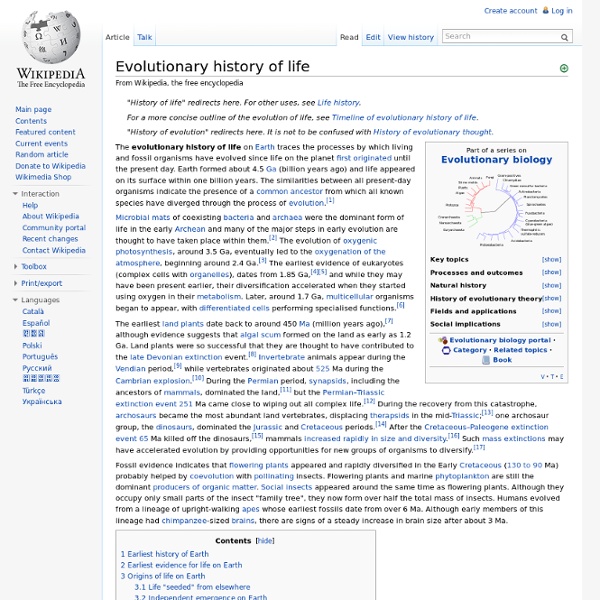



Earth Earth is the third planet from the Sun. It is the densest and fifth-largest of the eight planets in the Solar System. It is also the largest of the Solar System's four terrestrial planets. It is sometimes referred to as the world or the Blue Planet.[23] Earth formed approximately 4.54 billion years ago, and life appeared on its surface within its first billion years.[24] Earth's biosphere then significantly altered the atmospheric and other basic physical conditions, which enabled the proliferation of organisms as well as the formation of the ozone layer, which together with Earth's magnetic field blocked harmful solar radiation, and permitted formerly ocean-confined life to move safely to land.[25] The physical properties of the Earth, as well as its geological history and orbit, have allowed life to persist. Name and etymology In general English usage, the name earth can be capitalized or spelled in lowercase interchangeably, either when used absolutely or prefixed with "the" (i.e. Heat
"Evolution is Fact" Wikispecies, free species directory A New Thermodynamics Theory of the Origin of Life Why does life exist? Popular hypotheses credit a primordial soup, a bolt of lightning and a colossal stroke of luck. But if a provocative new theory is correct, luck may have little to do with it. Instead, according to the physicist proposing the idea, the origin and subsequent evolution of life follow from the fundamental laws of nature and “should be as unsurprising as rocks rolling downhill.” From the standpoint of physics, there is one essential difference between living things and inanimate clumps of carbon atoms: The former tend to be much better at capturing energy from their environment and dissipating that energy as heat. Jeremy England, a 31-year-old assistant professor at the Massachusetts Institute of Technology, has derived a mathematical formula that he believes explains this capacity. Kristian Peters Cells from the moss Plagiomnium affine with visible chloroplasts, organelles that conduct photosynthesis by capturing sunlight. Courtesy of Jeremy England Wilson Bentley
Welcome to ZipcodeZoo Sea anemone: genetically ½ animal, ½ plant A team led by evolutionary and developmental biologist Ulrich Technau at the University of Vienna has discovered that sea anemones display a genomic landscape with a complexity of regulatory elements similar to that of fruit flies or other animal model systems. This suggests that this principle of gene regulation is already 600 million years old and dates back to the common ancestor of human, fly and sea anemone. On the other hand, sea anemones are more similar to plants rather to vertebrates or insects in their regulation of gene expression by short regulatory RNAs called microRNAs. These surprising evolutionary findings are published in two articles in the journal Genome Research. Our appearance, the shape we have and how our body works is, in addition to environmental influences, largely the result of the action of our genes. However, genes are rarely single players, they rather act in concert and regulate each other's activity and expression in gene regulatory networks. …and in plants
323,899,142 occurrence records from 370 data publishers - GBIF Portal Try out the new GBIF portal! Why not try out the new GBIF portal at www.gbif.org, which has many more features and includes lots of information about the GBIF community, including great examples of data uses in research and interesting applications? The old GBIF data portal which you are viewing now will continue to be supported until we are satisfied it can be taken down without causing major inconvenience. Be aware that the content here is static and has not been updated since the launch of the new portal on 9 October 2013. Welcome to the (former) GBIF Data Portal Access 416,242,316 data records (363,215,360 with coordinates) shared via the GBIF network. Explore Species Find data for a species or other group of organisms. Species Information on species and other groups of plants, animals, fungi and micro-organisms, including species occurrence records, as well as classifications and scientific and common names. Example species: Puma concolor (Linnaeus, 1771) Explore Countries Countries France
CRACKED: 7 Animals That Are Evolving Right Before Our Eyes People who doubt evolution tend to have one main argument: "If evolution is true, why do we still see monkeys running around today, all chimp-like? Where are all the monkey-men I was promised?" Well, if you or someone you know refuses to believe that organisms change over time without proof on a monkey-man level, here are a buttload of animals in the middle of getting their evolve on. Well, seven anyway. Elephants are Evolving to Lose Their Tusks (and Avoid Poachers) Here's a joke: What did the elephant say to the poacher? Getty"Stop! Sorry about that. GettyAnd ever since animal rights got involved, unemployment has shot up 300 percent. So elephants have decided to take matters into their own hands ... or trunks or weirdly rounded three-toed feet or whatever. By 2005, it was estimated that the tuskless population had risen to between 5 and 10 percent. GettyJust like your debilitating lisp after reading that out loud Russian Dogs are Evolving to Learn the Subways Getty Check it: Via MSNBC
HOME